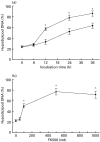Novel immunosuppressive effect of FK506 by augmentation of T cell apoptosis
- PMID: 11472421
- PMCID: PMC1906112
- DOI: 10.1046/j.1365-2249.2001.01586.x
Novel immunosuppressive effect of FK506 by augmentation of T cell apoptosis
Abstract
We have recently reported the accumulation of oligoclonal activated T cells in the spontaneously developed autoimmune pancreatitis in aly/aly mouse. In this study, we examined the effects of FK506 in this mouse model in preventing autoimmune pancreatitis and investigated its action on calcium signalling apoptosis of alymphoplasia (aly) lymphocytes in vitro. Mice were treated with FK506 from 8 to 25 weeks of age. At the age of 15 weeks, minimal mononuclear cell infiltration was observed in the pancreas in both the FK506 treated group and the control group. Furthermore, a marked cell infiltration associated with destruction of acini and partial fatty changes were observed in 25-week-old control mice. In contrast, FK506 treated mice showed almost no tissue destruction or mononuclear cell infiltration at the age of 25 weeks. Furthermore, at 15 weeks of age, most mononuclear cells in FK506-treated mice were TUNEL positive, whereas only a few were positive in control mice. This augmentation of T cell apoptosis by FK506 was confirmed using naive splenocytes activated by PMA and ionomycin in vitro. Finally, a suppressive effect of FK506 on Bcl-2 production but not on Bax production was confirmed by Western blotting. This unique effect of FK506 on the augmentation of T cell apoptosis is probably one of the mechanisms explaining its beneficial effect on aly autoimmune pancreatitis.
Figures





Similar articles
-
FK506 markedly enhances apoptosis of antigen-stimulated peripheral T cells by down-regulation of Bcl-xL.Transplantation. 1999 Oct 15;68(7):1018-23. doi: 10.1097/00007890-199910150-00020. Transplantation. 1999. PMID: 10532544
-
Cross-linking of the TCR-CD3 complex with CD4, CD8 or LFA-1 induces an anti-apoptotic signal in thymocytes: the signal is canceled by FK506.Int Immunol. 1995 Sep;7(9):1387-96. doi: 10.1093/intimm/7.9.1387. Int Immunol. 1995. PMID: 7495746
-
Superior T-cell suppression by rapamycin and FK506 over rapamycin and cyclosporine A because of abrogated cytotoxic T-lymphocyte induction, impaired memory responses, and persistent apoptosis.Transplantation. 2003 May 15;75(9):1581-90. doi: 10.1097/01.TP.0000053752.87383.67. Transplantation. 2003. PMID: 12792519
-
[Immunosuppressive activity of a microbial product].Nihon Yakurigaku Zasshi. 1997 Oct;110 Suppl 1:69P-74P. doi: 10.1254/fpj.110.supplement_69. Nihon Yakurigaku Zasshi. 1997. PMID: 9503409 Review. Japanese.
-
FK506 in the treatment of inflammatory skin disease: promises and perspectives.Immunol Today. 1996 Mar;17(3):106-8. doi: 10.1016/0167-5699(96)80599-8. Immunol Today. 1996. PMID: 8820265 Review.
Cited by
-
Cyclic nucleotide phosphodiesterases as targets for treatment of haematological malignancies.Biochem J. 2006 Jan 1;393(Pt 1):21-41. doi: 10.1042/BJ20051368. Biochem J. 2006. PMID: 16336197 Free PMC article. Review.
-
Effects of splenectomy on spontaneously chronic pancreatitis in aly/aly mice.Clin Dev Immunol. 2010;2010:614890. doi: 10.1155/2010/614890. Epub 2010 Mar 30. Clin Dev Immunol. 2010. PMID: 20369067 Free PMC article.
-
A concept on the role of Helicobacter pylori infection in autoimmune pancreatitis.J Cell Mol Med. 2005 Jan-Mar;9(1):196-207. doi: 10.1111/j.1582-4934.2005.tb00349.x. J Cell Mol Med. 2005. PMID: 15784177 Free PMC article.
-
Capecitabine Regulates HSP90AB1 Expression and Induces Apoptosis via Akt/SMARCC1/AP-1/ROS Axis in T Cells.Oxid Med Cell Longev. 2022 Mar 24;2022:1012509. doi: 10.1155/2022/1012509. eCollection 2022. Oxid Med Cell Longev. 2022. PMID: 35368874 Free PMC article.
-
Dermal Delivery of the High-Molecular-Weight Drug Tacrolimus by Means of Polyglycerol-Based Nanogels.Pharmaceutics. 2019 Aug 5;11(8):394. doi: 10.3390/pharmaceutics11080394. Pharmaceutics. 2019. PMID: 31387279 Free PMC article.
References
-
- Ellis RE, Yuan JY, Horvitz HR. Mechanism and functions of cell death. Annu Rev Cell Biol. 1991;7:663–98. - PubMed
-
- Smith CA, Williams GT, Kingston RE, Jenkinson J, Owen JJT. Antibodies to CD3/T-cell receptor complex induce cell death by apoptosis in immature T cells in thymic culture. Nature (Lond) 1989;337:181–4. - PubMed
-
- Ucker DS, Ashwell JD, Nichas G. Activation-driven T cell death: requirement for de novo transactivation and translation and association with genome fragmentation. J Immunol. 1989;143:3461–9. - PubMed
-
- Choi DW. Excitotoxic cell death. J Neurobiol. 1992;23:1261–76. - PubMed
MeSH terms
Substances
LinkOut - more resources
Full Text Sources
Other Literature Sources
Research Materials

